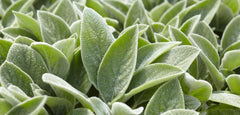Lamb's Ear (Stachys spp.)
Lamb's Ear Plant Features
The soft, gray-green foliage of lamb's ears or stachys, makes it a must-have plant for flower borders or containers. This low-maintenance sun worshipper grows only 12 to 15 inches tall, and works perfectly along border edges or as a fast-growing groundcover for an exposed location. Some members of the lamb's ears family aren't as fuzzy as others, but they are all pretty similar in color. In mid- to late summer, lamb's ears send up tall spikes of pink flowers that are attractive to butterflies and hummingbirds. The plants are deer resistant, too. Hardy from zones 4-9Lamb's Ears Questions?
Email us and one of our perennial experts will get back to you.
Lamb's Ear Growing Instructions
Lamb's ears require a sunny spot that receives at least 6 to 8 hours of direct sun a day. The plant is not fussy about soil type but prefers a well-drained soil that doesn't hold too much water after a rainstorm. In wet soil, lamb's ears may rot. Lamb's ears will quickly carpet an area with foliage, but has a tendency to die out in the middle after a few years so dig and divide your plants every few seasons. If the flower spikes flop over onto nearby plants simply clip them off at the base.Lamb's ears is not recommended for human or animal consumption.
-
Water
Low water needs
-
Light
Outside: Sun
-
Colors
Silver
-
Special Features
Attracts butterflies
Attracts hummingbirds
Colorful foliage
Deer/rabbit resistant
Groundcover
Super-easy to grow
Complement your Lamb's Ear
Dianthus, PerennialPerennial Dianthus and Cranesbill Geranium are spectacular planted along a border edge.
Coreopsis
The yellow blooms of Coreopsis seem to pop when showcased next to the silver foliage of Lamb's Ears.
Geranium, Perennial
Low growing Cranesbill Geranium makes a colorful partner for Lamb's Ears.

